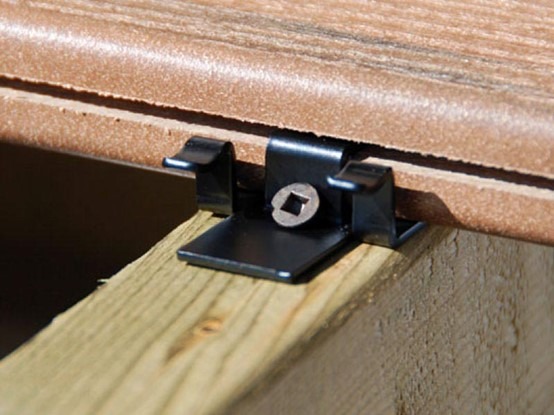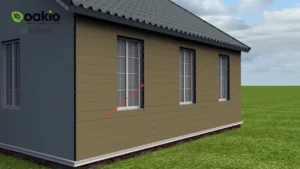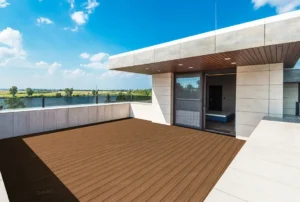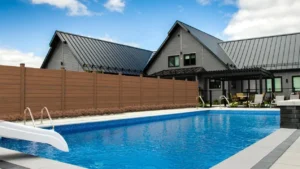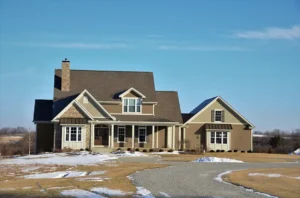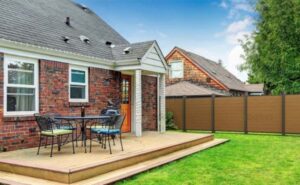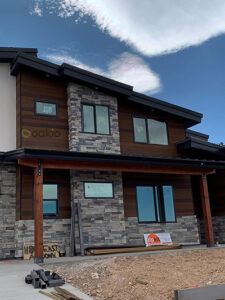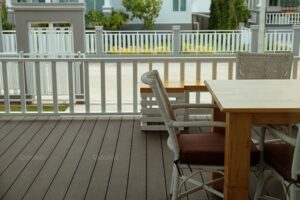Pros and Cons of Composite Decking Hidden Fasteners
When building composite decking, even the tiniest details are crucial if you are pursuing perfect composite decking installation. You’ve probably thought about things like the type of wood and protective cap you want to choose. But what about the parts that actually keep your deck intact? Here’s where composite decking hidden fasteners come in.
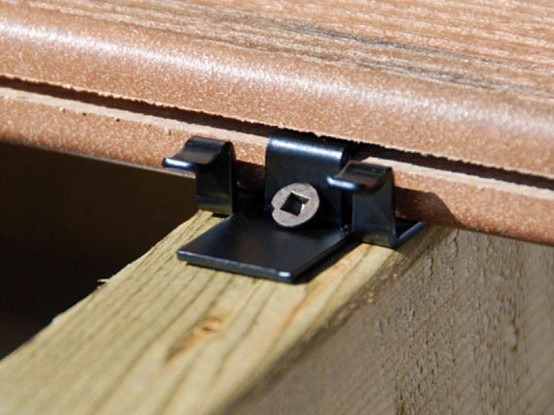
(The hidden fastener in this photo is just for reference. Different brand has different hidden fastener system.)
How the Composite Decking Hidden Fasteners Work
If you’ve ever looked at your composite decking, you might have seen those grooves on the sides of each board. These grooves are there for installing composite decking hidden fasteners.
Here’s how it works: Once the strips are ready, the builder places a board and uses a special tool or clip to secure it in place. Then, instead of screwing down directly from the top, they drive screws at an angle from the side of the board into the frame. This cleverly hides the screws between each board.
Different composite decking brands have various hidden fasteners for composite decking, so it’s essential to check with the manufacturer for the specific system you need.
While composite decking hidden fasteners help us construct a sleek and unblemished decking surface, it’s essential to weigh the pros and cons before deciding if they’re the right choice for your project.
Advantages of Composite Decking Hidden Fasteners
These nifty little components live up to their name – they’re excellent for building your decking and remaining unnoticeable. Apart from their concealment, they have more merits which make them more attractive.
1. Aesthetic Appeal
Composite decking hidden fasteners create a clean and seamless appearance on the surface of decking. With no visible screws or nails, the deck boasts a smooth and polished finish, enhancing its overall aesthetic appeal. This is particularly attractive for those who prefer a minimalist and contemporary look.
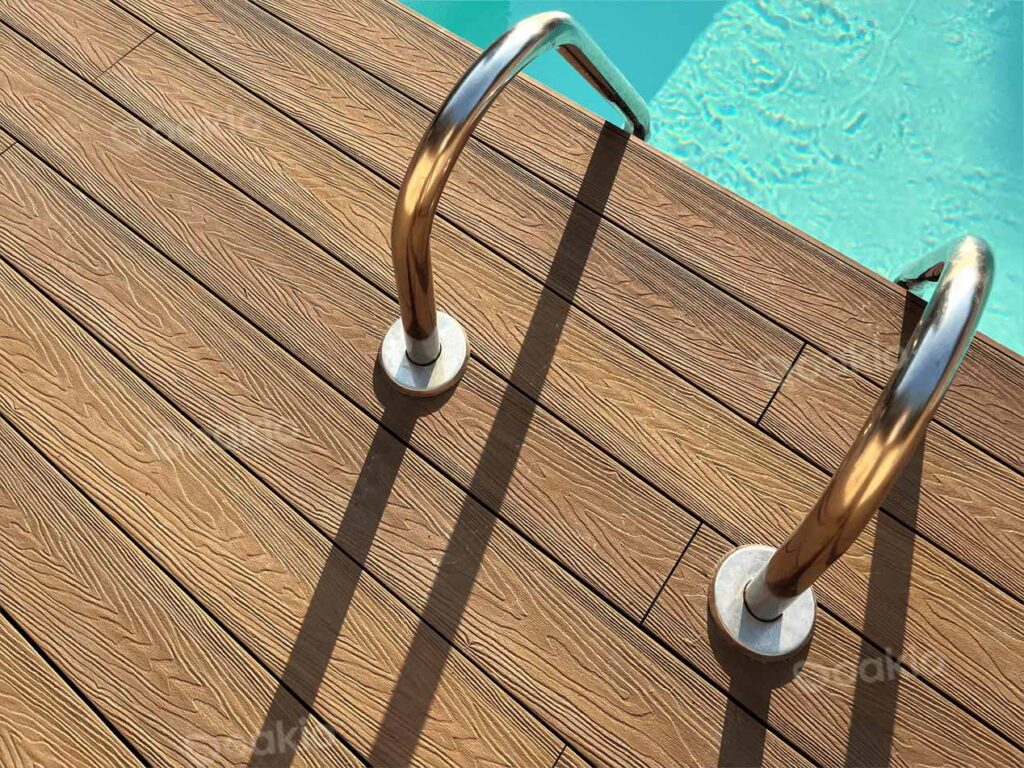
2. Safety & Comfort
The absence of protruding fasteners means a safer and more comfortable decking space. Traditional fasteners can present a tripping hazard, especially in bare feet. Hidden fasteners for composite decking eliminate this risk, providing a smooth and splinter-free deck surface for barefoot enjoyment.
3. Enhanced Durability
Exposed fasteners are more susceptible to the elements, leading to rust, corrosion, and potential degradation over time. Hidden fasteners, tucked away beneath the boards, are shielded from these external factors, contributing to the longevity and durability of the composite decking structure.
4. Easy Maintenance
The maintenance of composite decking with hidden fasteners is simplified. Without exposed screws or nails to inspect and tighten, routine maintenance becomes more straightforward. This is particularly advantageous for those seeking a low-maintenance outdoor living space.
5. Uniform Gaps
Composite decking hidden fasteners systems often come with built-in spacing guides, ensuring consistent gaps between boards. This not only enhances the visual appeal of the composite decking by providing a uniform look but also aids in proper water drainage and ventilation.
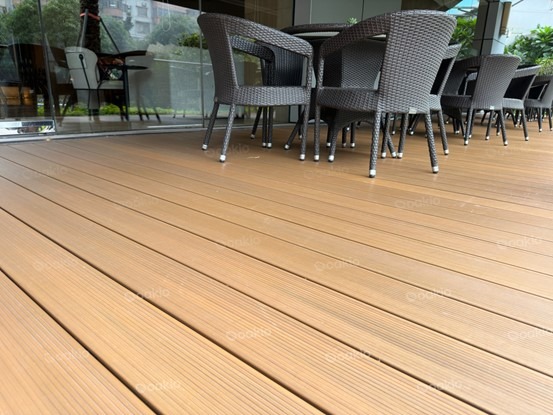
Disadvantages of Composite Decking Hidden Fasteners
However, just like a coin has two sides, we also need to learn about the demerits of the composite decking hidden fasteners, which will help you make better decision on whether choosing them or not.
1. Installation Complexity
While hidden fasteners offer a polished look, the installation process can be more complex than using traditional fasteners. Precise alignment and spacing are crucial, requiring careful attention to detail during installation. This complexity may result in a longer and potentially more challenging setup.
2. Cost Considerations
Composite decking hidden fasteners systems tend to be more expensive than traditional fasteners. The initial investment can be a deterrent for budget-conscious homeowners. However, some argue that the long-term benefits, such as reduced maintenance costs, may outweigh the higher upfront expense.
3. Limited Adjustment
Once installed, hidden fasteners offer limited flexibility for adjustments. If decking with hidden fasteners need to be replaced or repositioned, it can be more challenging to access and address specific areas. This limitation may be a concern for those who anticipate future modifications to their floor.
4. Compatibility Challenges
Not all composite decking materials are compatible with hidden fastener systems. Before committing to this installation method, it’s crucial to ensure that both the chosen decking material and the selected hidden fastener system are designed to work together. Incompatibility may lead to issues with decking’s stability and performance.
5. Potential Noise Issues
In some cases, hidden fasteners for composite decking may result in a noisier deck. The absence of screws securing the boards tightly to the joists can allow for more movement, potentially leading to creaking or squeaking sounds when walking on the deck. This can be an annoyance for homeowners seeking a quiet and serene outdoor space.
Conclusion
The decision to use hidden fasteners for composite decking involves a careful consideration of the specific needs and preferences of the homeowner. While the aesthetic benefits and safety advantages are notable, the potential complexities and higher costs should not be overlooked.
For those who prioritize a sleek and contemporary look, are willing to invest in a premium installation method, and are committed to meticulous planning during setup, composite decking hidden fasteners can be an excellent choice. However, if budget constraints, ease of installation, and future adjustability are top priorities, traditional fasteners may be a more practical option.
Ultimately, the pros and cons of composite decking hidden fasteners underscore the importance of evaluating individual priorities and weighing the trade-offs to ensure a satisfying and enduring outdoor living space.
Trending Reading
What Are the Differences Between the WPC Board and PVC Board?
[2024 Update] How Long Does WPC Decking Last?
